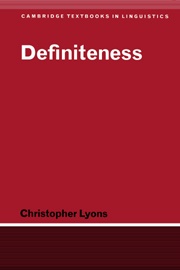
-
Select format
-
- Publisher:
- Cambridge University Press
- Publication date:
- December 2009
- March 1999
- ISBN:
- 9780511605789
- 9780521362825
- 9780521368353
- Dimensions:
- (228 x 152 mm)
- Weight & Pages:
- 0.76kg, 402 Pages
- Dimensions:
- (228 x 152 mm)
- Weight & Pages:
- 0.742kg, 404 Pages
You may already have access via personal or institutional login
Book description
This 1999 textbook investigates definiteness both from a comparative and a theoretical point of view, showing how languages express definiteness and what definiteness is. It surveys a large number of languages to discover the range of variation in relation to definiteness and related grammatical phenomena, such as demonstratives, possessives and personal pronouns. It outlines work done on the nature of definiteness in semantics, pragmatics and syntax, and develops an account on which definiteness is a grammatical category represented in syntax as a functional head (the widely discussed D). Consideration is also given to the origins and evolution of definite articles in the light of the comparative and theoretical findings. Among the claims advanced are that definiteness does not occur in all languages, though the pragmatic concept which it grammaticalizes probably does.
Contents
Metrics
Full text views
Full text views help Loading metrics...
Loading metrics...
* Views captured on Cambridge Core between #date#. This data will be updated every 24 hours.
Usage data cannot currently be displayed.
Accessibility standard: Unknown
Why this information is here
This section outlines the accessibility features of this content - including support for screen readers, full keyboard navigation and high-contrast display options. This may not be relevant for you.
Accessibility Information
Accessibility compliance for the PDF of this book is currently unknown and may be updated in the future.


